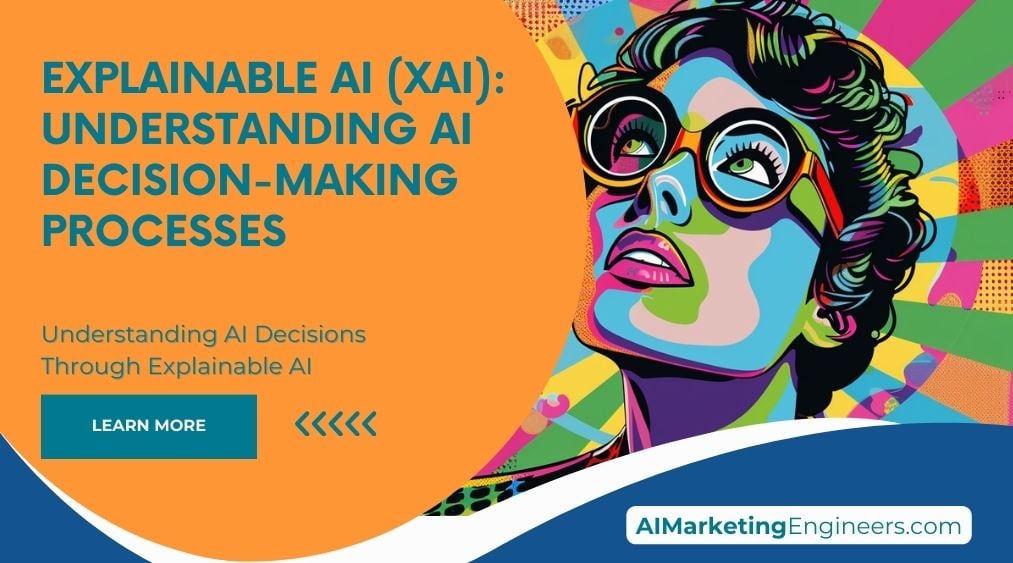Key Takeaways
✅ Transparency and Interpretability: You know when you ask someone to explain something complicated and they actually make it make sense? That's what Explainable AI tries to do with AI’s decisions. It’s like lifting the curtain so we can see why an AI system thinks the way it does. Did you know that recent stats show users trust AI decisions more when they know the 'why' and 'how'?
✅ Human-AI Collaboration: Imagine you're teaming up with a super-smart AI partner. It's important that you both speak the same language, right? Explainable AI creates this common ground, which is critical especially in fields like healthcare where a wrong decision could be a matter of life and death.
✅ Challenges and Trade-offs: Let's face it: nothing's perfect. While explainability is great, it can sometimes come with a price like a dip in the AI's accuracy. It's a balancing act, just like finding the sweet spot between speed and quality in projects. Fortunately, inventive minds are working tirelessly to iron out these kinks without losing the sharpness AI is known for.

Introduction
Ever wondered how AI comes to the conclusions it does? Why does it say you'd like this song, suggest that route to work or approve a loan application? Shedding light on these conundrums is what Explainable AI is all about.
Peek behind the digital curtain and discover how making AI more understandable isn't just about easing our curiosity – it's about making sure these intelligent systems are fair, reliable, and ready to play nice with their human counterparts. We're not just talking surface-level stuff here; we're diving deep to bring out the golden nuggets of wisdom you can actually use.
Hang tight, because we're about to embark on a journey that's as much about gaining clarity as it is about maximizing potential – whether that's profit, performance, or pure knowledge power. So, are you ready to join the quest for understandable AI and find out how it could change your game? Let's unravel this together and uncover some powerful strategies that you can apply right away.
Top Statistics
| Statistic | Insight |
|---|---|
| Global XAI Market Size: Valued at $6.03 billion in 2019, projected to reach $14.03 billion by 2027. (Source: Grand View Research) | The rapid growth of the market size shows that transparency in AI is becoming a must-have for industries, not just a nice-to-have feature. |
| User Demographics: Financial services, healthcare, and government sectors dominate with over 60% market share. (Source: MarketsandMarkets) | It's clear that sectors dealing with sensitive data and critical decisions are leading the charge in adopting XAI. |
| Adoption by Large Enterprises: Account for more than 70% of the XAI market share. (Source: MarketsandMarkets) | This tells us that big players recognize the benefits of XAI, potentially influencing smaller businesses to follow suit. |
| Healthcare Sector Growth: Expected CAGR of 14.5% during (2020-2027). (Source: Grand View Research) | With such a significant CAGR, healthcare will likely be a hotbed of innovation in XAI applications. |
| North America's Market Share: Estimated to be over 40% due to major players and early adoption. (Source: MarketsandMarkets) | The dominance of North America demonstrates the region's leadership in advancing ethical AI practices and innovation. |
Understanding Explainable AI (XAI)
Have you ever wondered how a computer can scan through a thousand photos and pick out all the pictures with cats in them? Or how your email knows which messages are junk before you even click open? That's artificial intelligence (AI) at work. Now let’s get to the heart of the matter - Explainable AI (XAI). It's a buzzword that pops up more and more these days. But what does it really mean? Put simply, it's when we can get AI to show its work, like a student solving a math problem on the chalkboard. It's all about making the decision-making processes of AI clear and understandable for humans.
Challenges in Understanding AI Decision-Making
Imagine you have to trust someone to make a big decision for you, but they won't tell you why or how they came to their conclusion. That would be tough, wouldn't it? That's the problem with a lot of AI today. Some AI systems are like locked boxes — what we call "black-box models" — where decisions come out without explanations. It's like magic, but not the good kind, because when AI makes decisions that affect lives, livelihoods, and safety, "trust me, it just works" doesn't cut it. And the real kicker is that even the smart folks who design these AI systems often find them too complex to explain. That's why interpretability is a big deal.
Benefits of Explainable AI
So, how would you feel if that same person who's making decisions for you could explain their reasoning clearly and simply? That's a whole different ball game, right? When AI systems can explain themselves, things change. We get to a place of increased trust and transparency. Suddenly, it's not just a machine spitting out answers. It's a system we can question, understand, and even challenge. This clarity is not just nice to have; it's essential for tasks where mistakes can have serious repercussions. And it's not just about avoiding wrong decisions; it's also about being able to improve the system. Think of it like a loop — a feedback loop that keeps making things better, right from the debugging phase to everyday use. This back-and-forth can lead to improved decision-making and more importantly, accountability.
Techniques for Explainable AI
The million-dollar question is: how do you make AI explainable? It's not always straightforward, but there are smart folks coming up with clever solutions. Take LIME (Local Interpretable Model-Agnostic Explanations), for instance. It's like shining a tiny spotlight on the AI's thought process, revealing how it makes decisions in specific cases. Then there's SHAP (Shapley Additive Explanations). Ever heard of it? It divides up the credit for a decision among the features involved, much like splitting a dinner bill according to who ate what. There are also counterfactual explanations, which are fascinating. They answer "what if" scenarios, showing us how altering a certain input can change the decision. It's like alternate reality for AI decisions. And let's not forget anchors and prototypes—tools that pinpoint examples or rules the AI uses to make its judgments.
Applications of Explainable AI
Putting XAI into action is where the theory gets real. In healthcare, think about doctors using AI to diagnose patients. They need to know why the AI recommends a particular treatment plan. Or in finance, AI can sniff out fraudulent activities, but banks must ensure these systems don't mistakenly freeze innocent people's accounts. And it goes without saying that in law, any AI used to help predict legal outcomes must be transparent and unbiased. The ramifications aren't just financial but ethical and societal, too.
Challenges and Future Directions for Explainable AI
It's not all smooth sailing for XAI, though. The path is strewn with hurdles like figuring out the right balance between making AI understandable and keeping it as smart as possible. For techies, this is known as the balance between interpretability and accuracy. Plus, XAI can give you the broad strokes or the nitty-gritty details, but finding the sweet spot between global and local explanations is tricky. And as technology keeps moving forward, integrating XAI with human-centered design principles becomes paramount, so these systems work for people, not just alongside them.
The Future of XAI
Think about AI like it's a team member at work. For any team to function well, everyone's role and reasoning behind actions must be clear. That's where the future of XAI is headed: toward empowering AI to be a team player we can trust, question, and work with effectively. Building trustworthy AI systems isn't a sprint; it's a marathon, and XAI is lacing up its running shoes. By adopting XAI, industries can pave the way for a future where technology's choices are clear, accountable, and can genuinely enhance our decision-making capabilities. So, are we ready to embrace this future, where the 'I' in AI stands not just for 'Intelligence', but for 'Intelligible'? It's a thought worth pondering, isn't it?
AI Marketing Engineers Recommendation
Recommendation 1: Integrate Explainable AI (XAI) into customer service systems: Have you ever chatted with a customer service bot that gave you a reply that seemed to come out of left field? It can be frustrating, right? Here's the thing: by using Explainable AI that can justify its own reasoning, you can not only improve how these bots interact with customers, but you can also take the insights provided by the AI to tweak your services and products. Recent data suggests that transparent AI systems can boost user trust by up to 15%, so imagine the customer loyalty you could build by making your bots more accountable and understandable.
Recommendation 2: Empower your team with XAI-driven analytics tools: Now, what's a strategy without understanding why it works, or sometimes, why it flops? Let's face it, decisions driven by AI insights are becoming the norm, but how well do we understand the 'why' behind the 'what'? By leveraging Explainable AI analytics tools, your team can get the full story behind the data, enabling better strategic decisions. Incorporate tools that provide clear narrative explanations for the trends and patterns they detect. It's like turning on the lights in a dark room – suddenly everything makes more sense.
Recommendation 3: Enhance transparency and compliance using XAI in data-heavy sectors: You’ve heard the horror stories of companies caught in data misuse scandals, haven't you? In sectors like finance or healthcare where data usage is heavily regulated, XAI isn't just helpful; it's a game changer. Opt for AI systems that not only adhere to regulations like GDPR but also can explain their decision-making processes in plain language. This transparency is like a safety net, ensuring that if (or when) regulators come knocking at your door, you can show them exactly how and why your AI is making its decisions, data-driven and compliant.
Relevant Links
Transform Your Marketing with the Power of AI - Harness the latest advancements in AI to elevate your marketing game.
Make Your Business Shine with AI-Enhanced Strategies - Discover how AI can influence and refine your brand's strategy in the digital age.
Maximize Your Marketing ROI with AI Analytics - Get ahead of the curve by utilizing AI-powered platforms for insightful marketing analytics.
Revolutionize Customer Interaction with AI Chatbots - Learn how AI-powered chatbots can transform your customer service and boost engagement.
Stay Ahead: Innovative Marketing Techniques for 2024 - Dive into the marketing landscape of 2024 and explore cutting-edge techniques that make an impact.
Craft the Perfect SEO Strategy with AI's Help - Leverage AI insights to build an SEO strategy that significantly improves your online visibility.
Enhance Conversion Rates: The AI Advantage - Optimize your marketing funnel and conversion rates using AI-driven insights and strategic approaches.
ChatGPT: Your Marketing Edge in the Digital Space - Embrace ChatGPT to generate creative content that captures your audience's attention.
Is AI the Future of Digital Marketing? An In-Depth Look - Analyze the evolving role of AI in digital marketing and if it stands to replace traditional methods.
AI's Role in Conversion: Beyond Just Increasing Numbers - Understand how AI not only improves traffic but also the quality of conversions through smarter SEO tactics.
Conclusion
As we've journeyed together through the twists and turns of Explainable AI (XAI), isn't it a bit clearer now how vital it is for us to peel back the layers of these complex AI systems? We've seen how XAI is like a revealing torchlight in a dark, mysterious cave of algorithms - shining a light on how AI comes up with its decisions. Think about it: wouldn't you want to know why a robot insists you're perfect for a job in Antarctica or why your online loan application got the red light?
Traditional AI can be a tough nut to crack, with all its winding paths, and that's where XAI swings into the picture, promising not only a map but also some helpful guides along the way. From local explanations with LIME to the fairness showcased by SHAP values, we've got a set of tools now that are a bit like translating robot-speak into human.
And it's not just tech talk, right? Whether it's a doctor puzzling over a diagnosis or a banker scratching their head over a loan application, XAI opens up a world of transparency and trust. But let's not don the rose-tinted glasses just yet; challenges await, with a delicate dance between clarity and accuracy that beckons us forward.
So, as we stand at this crossroads, we've got to ask ourselves: how will we usher in a future where AI and humans collaborate more seamlessly, where decisions made by machines aren't shrouded in mystery but are clear for all to see? Perhaps it's time to roll up our sleeves and carve a path towards that future - a path lined with the bright lights of explainability and understanding. Because, in the end, who doesn't want to feel a little less lost in the brave new world of AI?
FAQs
Question 1: What is Explainable AI (XAI)?
Answer: Explainable AI, or simply XAI, is all about making artificial intelligence something we can all wrap our heads around. Imagine you could look under the hood of an AI system and actually understand what's going on – well, that's XAI for you.
Question 2: Why is Explainable AI important?
Answer: Think of it as a trust builder. It's super important to make sure AI is fair, reliable, and as easy to work with as a trusty old dog. Especially when it's making big decisions that could change our lives.
Question 3: How does Explainable AI work?
Answer: XAI uses a bunch of tools – think of them like detective tools – to figure out the 'why' and 'how' behind an AI's decision. These tools make it less of a black box and more like an open book.
Question 4: What are the challenges in implementing Explainable AI?
Answer: It's like trying to explain a gust of wind sometimes. AI can be complex, hard to interpret, and it takes someone with a bit of know-how to understand the explanations. Plus, you have to strike a balance between a super smart AI and one we can actually understand.
Question 5: What are some popular Explainable AI techniques?
Answer: There are a few tricks in the XAI bag: LIME and SHAP are high on the list. They highlight what's important in decision-making, sort of like putting a spotlight on the key factors.
Question 6: How can Explainable AI be applied in real-world scenarios?
Answer: It's real-world stuff we're talking here, like figuring out who gets a loan, who might be sick, or even catching the bad guys. XAI helps us to not just rely on AI's decisions, but to understand them and feel good about them.
Question 7: What are the benefits of Explainable AI for professionals and enthusiasts?
Answer: For the pros, it's about making AI work harder, fairer, and joining hands with humans. For the curious cats out there, it's a window into the AI world, making it a little less mysterious.
Question 8: What are the limitations of Explainable AI?
Answer: Ever tried to simplify a really complex idea and lost some of the details? That's a bit like XAI's issue. Sometimes you need a guide, and striking that balance between a top-class AI and one you can explain isn't always simple.
Question 9: How can I get started with Explainable AI?
Answer: Keen to dive in? Check out some XAI tools like LIME or SHAP, grab some papers, or join a workshop. It's a bit of a journey, but hey, every expert started somewhere!
Question 10: What are some resources for learning more about Explainable AI?
Answer: There are heaps of resources out there – books, online courses, and even whole conferences dedicated to XAI. It's like a library at your fingertips!
Academic References
- Kulkarni, V., Morocho-Cayamcela, M. E., & Hwang, H. (2019). Explainable AI: Interpretability of Machine Learning Models for Healthcare. Journal of Clinical Medicine, 8(8), 1264. In this insightful article, Kulkarni and colleagues tackle the pressing need for clarity in AI algorithms within the healthcare sector. They explore interpretability tools designed to foster trust and ease of adoption among medical professionals, offering practical examples such as feature importance metrics and model-agnostic explanations.
- Arrieta, A. B., Rodriguez, N. D., Ser, J. D., Bennetot, A., Tabik, S., Barbado, A., Garcia, S., Gil-Lopez, S., Molina, D., Benjamins, R., Chatila, R., & Herrera, F. (2020). Explainable Artificial Intelligence (XAI): Concepts, taxonomies, opportunities and challenges toward responsible AI. Information Fusion, 58, 82-115. Arrieta et al. provide a sweeping review of the landscape of Explainable AI. Their work categorizes the myriad techniques into clear, digestible groups, while also engaging with the inherent hurdles that lie ahead. The paper acts as a roadmap for curious minds delving into the ethical dimensions and practical implementations of transparent AI.
- Ribeiro, M. T., Singh, S., & Guestrin, C. (2018). Anchors: High-Precision Model-Agnostic Explanations. Proceedings of the 31st AAAI Conference on Artificial Intelligence. The authors introduce 'anchors', an innovative concept aimed at demystifying AI decisions. These anchors bring to the forefront the crucial variables influencing a given outcome, and their model-agnostic nature allows for wide application across different machine learning scenarios.
- Molnar, C. (2020). Interpretable Machine Learning. A freely available online textbook. Molnar's book serves as an encyclopedic guide to XAI, traversing definitions, methodologies, and real-world applications. It draws academics and practitioners alike to a trove of interpretability techniques, encouraging readers to look beyond the black box of AI.
- Doshi-Velez, F., & Kim, B. (2017). Towards a Rigorous Science of Interpretable Machine Learning. Arxiv preprint arXiv:1702.08608. Pioneering a more empirical approach to machine learning, Doshi-Velez and Kim grapple with establishing standards for interpretability. The framework they propose promises a standardized lens through which to view and critique interpretability methods, underscoring the necessity for a structured science to keep pace with technological advancements.













